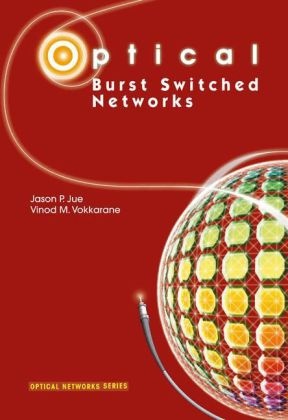Read more
Next-generation high-speed Internet backbone networks will be required to support a broad range of emerging applications which may not only require significant bandwidth, but may also have strict quality of service (QoS) requirements. Furthermore, the traffic from such applications are expected to be highly bursty in nature. For such traffic, the allocation of static fixed-bandwidth circuits may lead to the over-provisioning of bandwidth resources in order to meet QoS requirements.
Optical burst switching (OBS) is a promising new technique which attempts to address the problem of efficiently allocating resources for bursty traffic. In OBS, incoming data is assembled into bursts at the edges of the network, and when the burst is ready to be sent, resources in the network are reserved only for the duration of the burst. The reservation of resources is typically made by an out-of-band one-way control message which precedes the burst by some offset time. By reserving resources only for the duration of the burst, a greater degree of utilization may be achieved in the network.
This book provides an overview of optical burst switching. Design and research issues involved in the development of OBS networks are discussed, and approaches to providing QoS in OBS networks are presented. Topics include:
- Optical burst switching node and network architectures
- Burst assembly
- Signaling protocols
- Contention resolution
- Burst scheduling
- Quality of service in OBS networks
List of contents
Dedication
List of Figures
List of Tables
Preface
1. Introduction
1.1 Optical Circuit Switching
1.2 Optical Packet Switching
1.3 Optical Burst Switching
References
2. Technology And Architecture
2.1 OBS Network Architecture
2.2 Enabling Technology
2.3 Physical-Layer Issues
References
3. Burst Assembly
3.1 Timer and Threshold Selection
3.2 Effect of Burst Assembly on Traffic Characteristics
3.3 Evaluation of Threshold-Based Burst Assembly Techniques
References
4. Signaling
4.1 Classification of Signaling Schemes
4.2 Just-Enough-Time (JET)
4.3 Tell-and-Wait (TAW)
4.4 Intermediate Node Initiated (TNT) Signaling
4.5 Analytical Delay Model
4.6 Numerical Results
References
5. Contention Resolution
5.1 Optical Buffering
5.2 Wavelength Conversion
5.3 Deflection Routing
5.4 Burst Segmentation
5.5 Segmentation with Deflection
5.6 Contention Resolution and QoS
References
6. Channel Scheduling
6.1 Segmentation-Based Channel Scheduling
6.2 OBS Core Node Architecture
6.3 Segmentation-Based Non-Preemptive Scheduling Algorithms
6.4 Segmentation-Based Non-Preemptive Scheduling Algorithms with FDLs
6.5 Numerical Results
References
7. Quality Of Service
7.1 Relative QoS in OBS Networks
7.2 Absolute QoS
References
8. Other Topics
8.1 Labeled OBS
8.2 Multicasting in OBS
8.3 Protection for Optical Burst-Switched Networks
8.4 TCP over OBS
8.5 OBS Testbeds
References
Index
Summary
Next-generation high-speed Internet backbone networks will be required to support a broad range of emerging applications which may not only require significant bandwidth, but may also have strict quality of service (QoS) requirements. Furthermore, the traffic from such applications are expected to be highly bursty in nature. For such traffic, the allocation of static fixed-bandwidth circuits may lead to the over-provisioning of bandwidth resources in order to meet QoS requirements.
Optical burst switching (OBS) is a promising new technique which attempts to address the problem of efficiently allocating resources for bursty traffic. In OBS, incoming data is assembled into bursts at the edges of the network, and when the burst is ready to be sent, resources in the network are reserved only for the duration of the burst. The reservation of resources is typically made by an out-of-band one-way control message which precedes the burst by some offset time. By reserving resources only for the duration of the burst, a greater degree of utilization may be achieved in the network.
This book provides an overview of optical burst switching. Design and research issues involved in the development of OBS networks are discussed, and approaches to providing QoS in OBS networks are presented. Topics include:
- Optical burst switching node and network architectures
- Burst assembly
- Signaling protocols
- Contention resolution
- Burst scheduling
- Quality of service in OBS networks
Additional text
From the reviews:
"The authors of this book emphasize optical burst switching (OBS) … covering a multitude of aspects. The book is structured and enriched to attract managers, researchers, system designers … . A positive aspect of this book is the important practical approach … . Well thought-out, tested, and fully discussed schemes and techniques for the deployment of future OBS systems are presented. … This book clearly stands out. … It will be a valuable asset to professionals, researchers, and students … ." (Harry Skianis, Computer Reviews, April, 2005)

